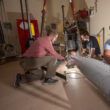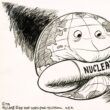In Round Three, Baldev Raj and P.R. Vasudeva Rao claim to have identified "several technical inaccuracies" in my Round Two essay. I consider their claims misleading.
For example, I wrote that "high-level waste, long-lived intermediate waste, and low-level waste [from plutonium reprocessing and recycling] … must eventually be buried, so reprocessing does not eliminate the need for repositories." Raj and Rao respond that "only high-level waste requires burial in deep geological repositories. Intermediate waste can be buried in shallower repositories." But long-lived intermediate-level waste produced through plutonium reprocessing and recycling indeed must be buried in a deep repository (while shallow burial is adequate for short-lived radioactive waste). My key point, however, was that reprocessing does not eliminate the need for repositories. Raj and Rao essentially ignore this idea.
Raj and Rao also mischaracterize my argument that the capacity at China's envisioned repository for high-level waste in Gansu Province would merely double if all transuranic elements were separated from nuclear waste—and that the same increase could be achieved by waiting 100 years before burying the waste. Raj and Rao dispute my statements by comparing the toxicity of reprocessed waste to the toxicity of waste that has not been reprocessed. But my focus in Round Two was on reductions in the volume of the waste that China envisions placing in its Gansu repository. I made no claim about toxicity.
All in all, regarding volumes of nuclear waste, I agree with my roundtable colleague Klaus Janberg, who wrote in Round Two that a thorough accounting of all waste streams involved in reprocessing and breeder reactors makes the once-through cycle "clearly superior."
Easy choice. Lately, advocates for fast neutron reactors have been arguing that breeders and reprocessing can reduce the long-term hazards associated with burial of high-level waste. But these long-term benefits are offset by short-term risks and costs. For example, breeder advocates argue that the risks surrounding leakage in geological repositories could be reduced if all the long-lived isotopes of plutonium and other transuranics contained in spent fuel were transmuted (or fissioned), thus significantly reducing the doses of radioactivity that could escape due to any leakage. But studies show that long-lived fission and activation products in spent fuel—not isotopes that could be fissioned through breeders and reprocessing—dominate the radioactivity doses that leakage could release. Plutonium, in fact, is quite insoluble in deep underground water. So, reprocessing delivers no obvious long-term benefits in reducing leaked doses of radioactivity—but it does involve routine releases of long-lived radioactive gases from spent fuel. Reprocessing also increases the risk that tanks for high-level liquid waste might explode. (In a similar vein, advocates for fast neutron reactors argue that reprocessing, by reducing the need to mine uranium, can reduce human radiation exposure. But any such benefit is canceled out because plutonium reprocessing and recycling themselves expose workers and the public to radiation. In short, the net effects may well be negative.)
Meanwhile, all reprocessing and fast neutron reactor programs currently under consideration significantly increase the economic costs of nuclear energy. This means that nuclear decision makers must choose between achieving rather insignificant reductions in the long-term hazards associated with nuclear waste—and achieving short-term gains in the areas of safety, security, human health, and the environment. The choice seems rather clear-cut. The US National Academy of Sciences concluded in 1996, based on a review of the costs and benefits of reprocessing and fast neutron reactor programs, that "none of the dose reductions seem large enough to warrant the expense and additional operational risk of transmutation." That assessment remains valid today.
Finally, Raj and Rao assert that Janberg and I have not contested their argument that "today's generation bears an obligation to future generations not to deplete the world's uranium resources." Instead, Raj and Rao write that Janberg and I "have focused on economic questions, waste issues, and also on India's nuclear weapons program… ." But why shouldn't Janberg and I discuss issues—such as economics, waste, and nuclear proliferation—that must be satisfactorily addressed if sustainable systems for nuclear power are to be established? And even if one devotes as much attention to the future availability of uranium as Raj and Rao would like, does reprocessing make sense if uranium remains cheaply available, as seems likely, for a long time to come?
Topics: Nuclear Energy, Nuclear Weapons
Share: [addthis tool="addthis_inline_share_toolbox"]














